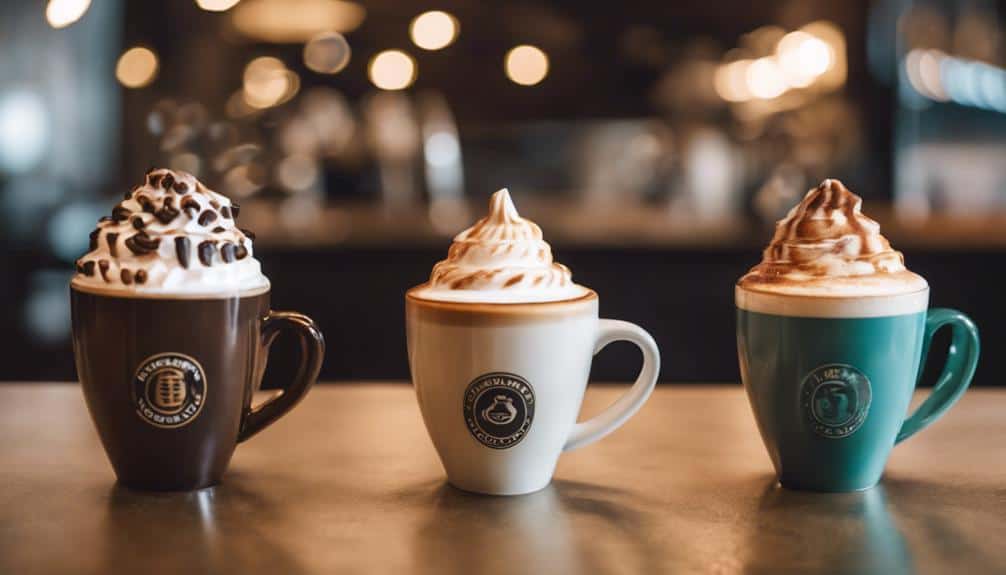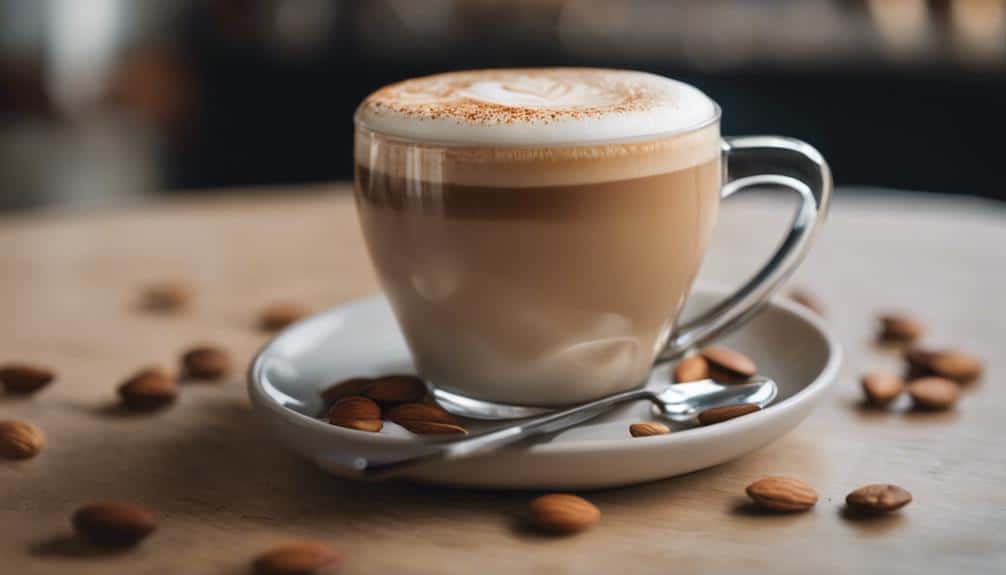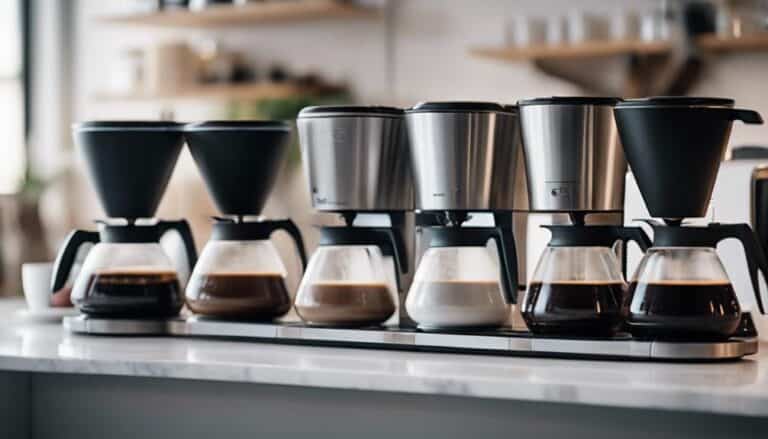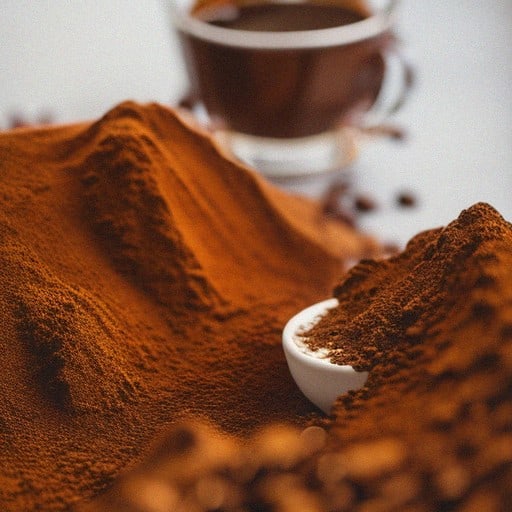Lattes Vs Cappuccino Showdown: 10 Key Differences

As a coffee enthusiast, I've always found the debate between lattes and cappuccinos intriguing. The subtle nuances between these two beloved beverages go beyond just the milk-to-espresso ratio, delving into aspects like texture, flavor, and customization. Each has its own loyal following, but the real question remains – which one truly reigns supreme in the world of espresso-based drinks? Let's explore the 10 key differences that set lattes and cappuccinos apart and uncover the secrets behind these popular caffeinated creations.
Milk-to-Espresso Ratio
When crafting the perfect latte or cappuccino, understanding the essential milk-to-espresso ratio sets the foundation for achieving the desired taste and texture. In a latte, the milk-to-espresso ratio is typically 1:3, resulting in a milder and sweeter taste compared to a cappuccino. The higher milk content in a latte influences its flavor profile, providing a creamy and smooth texture that complements the espresso flavor.
On the other hand, a cappuccino boasts equal parts espresso, steamed milk, and milk foam, offering a stronger espresso flavor with a bolder taste. The foam layer in a cappuccino adds a touch of sweetness and creaminess, balancing the robustness of the espresso.
Texture and Frothiness
Experiencing the contrasting textures and frothiness in lattes and cappuccinos reveals a rich sensory journey through the world of coffee craftsmanship.
Cappuccinos greet you with a robust texture, boasting a thicker and denser foam layer that enhances the espresso flavor. The structured layers of espresso, steamed milk, and foam in a cappuccino create a distinct mouthfeel, offering a unique sensation with each sip.
On the other hand, lattes present a creamier texture, with a lighter foam layer that adds a subtle sweetness to the mix. The integration of espresso and steamed milk in lattes results in a silkier texture, providing a comforting mouthfeel that glides smoothly on the palate.
Whether you prefer the bold and structured layers of a cappuccino or the smooth and comforting blend of a latte, the world of coffee offers a delightful array of textures and frothiness to suit every palate.
Flavor Profiles

When it comes to the flavor profiles of lattes and cappuccinos, the milk froth levels and espresso to milk ratio play an important role.
Lattes, with their higher milk content, offer a smoother and creamier taste, while cappuccinos, with a stronger espresso presence, deliver a bold and robust flavor.
Understanding these key differences in flavor composition is essential in choosing between the two beloved coffee classics.
Milk Froth Levels
Crafting the perfect milk froth in your espresso-based drink can elevate your coffee experience to new heights, distinguishing between the rich intensity of a cappuccino and the smooth sweetness of a latte. The milk froth levels play an essential role in defining these distinctions.
Cappuccinos boast a thicker foam layer, intensifying the espresso flavor with a bolder taste profile. This velvety texture adds a creamy dimension, enhancing the overall coffee experience.
On the other hand, lattes offer a lighter foam layer and a higher milk-to-espresso ratio, resulting in a sweeter taste and a more milk-forward profile. These varying preferences in milk froth levels cater to individual tastes, providing a spectrum of choices for coffee enthusiasts seeking unique flavor profiles.
Espresso to Milk Ratio
The harmony between espresso intensity and creamy milk texture in both lattes and cappuccinos is intricately woven through their distinct espresso to milk ratios, shaping their unique flavor profiles.
Lattes, with a milk-to-espresso ratio of 3:1, deliver a milder and sweeter taste profile, accentuating the creamy texture that defines them.
On the other hand, cappuccinos present a bolder flavor experience by featuring equal parts espresso, steamed milk, and milk foam. The strong espresso flavor in cappuccinos arises from this balanced ratio, creating layers of richness that tantalize the taste buds.
Understanding the importance of the espresso to milk ratio in these beloved beverages is key to appreciating the nuances in their flavor profiles and enjoying the delightful contrast between a velvety latte and a robust cappuccino.
Preparation Techniques
In mastering the art of preparing lattes and cappuccinos, the key lies in perfecting the frothing technique to achieve the desired texture and richness.
When it comes to lattes, the process involves steaming milk to create a creamy texture that complements the espresso. The milk is aerated to give it a silky smoothness that blends harmoniously with the coffee.
On the other hand, cappuccinos require equal parts espresso, steamed milk, and milk foam, usually served in smaller cups. The frothing for cappuccinos is done differently, resulting in a thicker foam layer that sits atop the espresso and milk mixture.
Baristas play an essential role in expertly frothing the milk to create the perfect balance of flavors and textures in both drinks. The frothing process is where the magic truly happens, transforming simple ingredients into luxurious and indulgent beverages that delight the senses.
Customization Options

When personalizing your latte or cappuccino, the possibilities are endless, allowing you to immerse yourself in tailoring every sip to your unique preferences and tastes.
For lattes, you can indulge in a myriad of flavored syrups like vanilla, hazelnut, or caramel, elevating the taste profile to suit your mood.
On the other hand, cappuccinos offer versatility through options like wet cappuccinos with more milk for a creamier texture or dry cappuccinos boasting extra foam for a lighter feel.
Both beverages can be adorned with delightful toppings such as chocolate powder, cinnamon, or whipped cream, adding an extra layer of flavor and visual appeal.
Engage with the exploration of customization by experimenting with different milk types – whole milk, skim milk, or almond milk – to play with the texture and richness of your drink. Adjust the milk-to-espresso ratio and explore unique flavor combinations to curate a personalized coffee experience that caters specifically to your palate.
Nutritional Variances
Lattes and cappuccinos display distinct nutritional profiles, showcasing variations in protein, vitamins, and calorie content that cater to diverse dietary needs.
Lattes, being more nutrient-dense, offer a higher protein and vitamin content, making them a favorable choice for individuals seeking a more substantial nutritional boost.
On the other hand, cappuccinos have a lower calorie count, which can appeal to those watching their overall calorie intake. The calcium content also differs between the two, with lattes providing a higher calcium intake due to their increased milk content.
These variations in nutrient profile between lattes and cappuccinos highlight the importance of considering not just taste but also the impact on your overall nutritional values. Whether it's the caffeine content, protein levels, or vitamin content, the choice between lattes and cappuccinos can greatly influence your daily nutrient intake and overall well-being.
Caffeine Content

Exploring the world of coffee beverages, one cannot overlook the pivotal role that caffeine content plays in distinguishing between lattes and cappuccinos. In espresso-based beverages like lattes and cappuccinos, caffeine levels are primarily determined by the number of espresso shots used in the drink. The caffeine content per shot of espresso is the same in both lattes and cappuccinos, but variations arise based on the milk-to-espresso ratio and the number of shots added.
To better understand the impact of caffeine levels on these beloved drinks, let's delve into the relationship between caffeine content, flavor intensity, and texture. The table below highlights the key differences in caffeine content and its influence on the overall experience of lattes and cappuccinos:
| Aspect | Lattes | Cappuccinos |
|---|---|---|
| Caffeine Content | Equal per espresso shot | Equal per espresso shot |
| Milk-to-Espresso Ratio | More milk, less coffee | Equal parts milk and coffee |
| Flavor Intensity | Creamier, milder | Stronger, bolder |
| Texture | Creamy, smooth | Frothy, velvety |
Understanding these nuances in caffeine content empowers coffee enthusiasts to make informed choices based on their preferences for flavor, intensity, and texture.
Types of Variations
In the world of coffee variations, the diversity of cappuccino styles offers a range of textures and flavor profiles to suit every preference. From the classic traditional cappuccino with its equal parts espresso, steamed milk, and foam to the bone dry cappuccino that focuses on a strong espresso flavor with a frothy foam topping, each variation brings its own unique characteristics to the table.
If you prefer a thicker milk foam layer, the wet cappuccino might be your go-to choice, providing a luxurious mouthfeel. On the other hand, the dry cappuccino offers a drier texture by incorporating less steamed milk and more foam. For those who enjoy a creamier consistency, the super wet cappuccino with its increased steamed milk content could be a delightful option. And let's not forget the bone dry cappuccino, where the espresso flavor shines through with minimal to no steamed milk interference, topped with a frothy foam that enhances the overall experience. Each variation caters to different preferences, allowing you to find the perfect flavor profile that suits your taste buds.
Milk Choices and Calories

Indulging in the world of coffee means considering the impact of milk choices on the richness, flavor, and calorie content of your favorite espresso-based drinks. When it comes to lattes and cappuccinos, the type of milk you choose can noticeably influence the overall experience.
Here's a breakdown to help you make an informed decision:
- Whole Milk: Adds richness and creaminess, leading to a higher calorie count compared to cappuccinos.
- Skim Milk: A lower-calorie option that reduces the overall calorie content while maintaining texture.
- Almond Milk or Soy Milk: Dairy alternatives with different calorie counts and nutritional benefits, altering the drink's profile.
- Coconut Milk: A popular non-dairy option with a unique flavor profile that impacts taste and calorie content.
The nutritional benefits, fat levels, and protein levels of your latte or cappuccino can vary based on the milk you select. Choose wisely to tailor your coffee experience to your preferences while keeping an eye on the calorie count.
Personal Preference
When it comes to coffee, my taste buds are my compass. The delicate dance between the creamy milk and bold espresso in a latte or the rich foam atop a cappuccino can make all the difference.
Choosing between lattes and cappuccinos is like selecting a symphony for my senses – each sip, a unique experience tailored to my flavor preferences.
Flavor Preferences
Revealing the intricate dance of flavors that define our coffee experience, the choice between lattes and cappuccinos hinges on our unique taste preferences. When it comes to flavor preferences:
- Some enjoy the milder and sweeter taste of lattes, characterized by a higher milk-to-espresso ratio.
- Others savor the bolder taste of cappuccinos, with a stronger espresso flavor.
- Personal preference plays an essential role in determining which of these two beverages aligns best with one's taste preferences.
- Experimenting with both lattes and cappuccinos is key to discovering the flavor profile that resonates most with individual tastes.
Understanding these distinctions allows us to fully appreciate the nuances of each coffee type and tailor our choices to suit our unique palate preferences.
Milk Foam Ratio
Exploring the world of coffee indulgence, the milk foam ratio in lattes and cappuccinos emerges as a pivotal factor driven by personal preferences. Cappuccinos boast a higher foam ratio, creating a thicker layer of foam that enhances the bold and intense espresso flavor.
On the other hand, lattes feature a lower foam ratio, resulting in a smoother texture that offers a milder coffee experience. The choice between these foam ratios ultimately comes down to personal preference. Some may prefer the bolder flavor and thicker foam of cappuccinos, while others opt for the creamier, softer taste of lattes.
Whichever foam ratio you choose, both lattes and cappuccinos promise a delightful coffee experience tailored to your unique preferences.
Conclusion
As a coffee enthusiast, the debate between lattes and cappuccinos will always be a passionate one for me.
The subtle differences in milk-to-espresso ratios, textures, and flavor profiles truly showcase the artistry and complexity of these beloved espresso-based drinks.
Whether you prefer the smooth creaminess of a latte or the bold robustness of a cappuccino, the choice ultimately comes down to personal preference and the unique experience each beverage offers.
Cheers to enjoying your favorite coffee creation!





